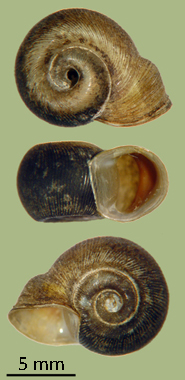> Habitat & Distribution
This
is primarily a species of colder latitudes, above the glacial
maximum. Baker (1945) gave the range of Helisoma campanulatum
as Labrador, Quebec and Ontario south to New York, Ohio, and
Illinois. We have documented sparse populations scattered
across
the northern latitudes of the present study area, from Illinois
through Indiana, Pennsylvania and New Jersey.
Throughout this chilly range, H.
campanulatum
is exclusively an inhabitant of lentic waters, especially the larger
lakes. Clampitt (1973) reported no substrate preference in
Douglas Lake, Michigan, but the observations of Laman and colleagues
(1984) suggested a preference for depths of 3 6 m. Helisoma campanulatum
is peripheral in our 17-state study region, FWGNA incidence rank I-3p.
> Ecology & Life History
Jokinen s (1987) analysis of freshwater gastropod distribution in southern New England led her to classify H. campanulatum as an A-B tramp, present on most species-rich islands but less on species-poor islands. Dillon s (2000: 360-364) re-analysis of Jokinen's data on the distribution of freshwater gastropods in Connecticut confirmed the association of H. campanulatum with large and rich lakes, while suggesting an Undifferentiated life history strategy. Both McKillop (1985) and Jokinen (1985) reported simple annual (Type A) life cycles. See my essay of 9Sept20 from the link below for a figure of the juvenile shell morphology.
> Taxonomy & Systematics
As has been the case in all the groups of North American freshwater pulmonates, the shell phenotypic plasticity displayed by populations of H. campanulatum led previous generations of malacologists to describe a proliferation of lower-level taxa, and a proliferation of higher-level taxa to contain them. Baker (1945) grouped eight subspecies of H. campanulatum together with H. multivolvis (Case) in the subgenus Planorbella, which Burch (following Taylor 1966) promoted to genus rank. But we agree with Hubendick (1955) that the relatively minor attribute of shell coiling apparently the basis for this move does not warrant recognition of Planorbella at the generic level. See my essay of 11Apr08 from the link below for more.
> Maps and Supplementary Resources
- Helisoma distribution in the drainage of The Ohio (2019)
- Helisoma campanulatum distribution in Atlantic drainages (2023)
> Essays
- See my post to the FWGNA blog of 11Apr08 for a review of the Classification of the Planorbidae.
- Or view the (Hubendick 1955) classification of North American planorbids in a tabular format [here].
- See my post of 26Sept14 for good, comparative figures illustrating "The egg masses of freshwater pulmonate snails."
- The (rather ordinary) shell morphology demonstrated by juvenile H. campanulatum was compared to the (rather surprising) morphology of H. trivolvis in my essay of 9Sept90, Juvenile Helisoma.
> References
Baker, F.C. 1945.
The Molluscan Family Planorbidae. The University of Illinois Press.
Urbana, Illinois.
Clampitt, P. 1973.
Substratum as a factor in the distribution of pulmonate snails in
Douglas Lake, Michigan. Malacologia 12: 379-399.
Dillon, R. T., Jr. 2000.
The Ecology of Freshwater Molluscs. Cambridge
University Press 509 pp.
Hubendick,
B. 1955.
Phylogeny in the Planorbidae. Trans. Zool. Soc. London 28:
453-542.
Jokinen, E. 1985.
Comparative life history patterns within a littoral zone snail
community. Verh. Internat. Verein, Limnol. 22: 3292-3399.
Jokinen, E. 1987.
Structure of freshwater snail communities:
species-area relationships and incidence categories. Am. Malacol. Bull.
5: 9-19.
Laman, T., N. Boss, and
H. Blankespoor. 1984. Depth distribution of seven species
of gastropods in Douglas Lake, Michigan. Nautilus 98: 20-24.
McKillop, W. 1985.
Distribution
of aquatic gastropods across the Ordovician dolomite - Precambrian
granite contact in southeastern Manitoba, Canada. Can. J. Zool. 63:
278-288.
Taylor, D.
W. 1966. Summary of North American
Blancan nonmarine mollusks. Malacologia 4: 1 - 172.








